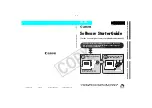
2:596
Volume 2, Part 2: IA-32 Application Support
9.1
Transitioning between Intel
®
Itanium
®
and IA-32
Instruction Sets
As mentioned earlier, user-level code can transition from Itanium to IA-32 (or back)
instruction sets without operating system intervention. As described in
“IA-32 Application Execution Model in an Intel
, two instructions are provided for this purpose:
br.ia
(an Itanium
unconditional branch), and JMPE (an IA-32 register indirect and absolute jump). Prior
to executing any IA-32 instructions, however, the Itanium architecture-based operating
system needs to setup an execution environment for executing IA-32 code.
9.1.1
IA-32 Code Execution Environments
Processors based on the Itanium architecture are capable of executing IA-32 code in
real mode, VM86 mode or protected mode. When segmentation is enabled both 16 and
32-bit code are supported. Prior to transferring control to IA-32 code, an Itanium
architecture-based application and/or operating system is expected to setup the
complete IA-32 execution environment in Itanium registers.
In particular, Itanium architecture-based software must setup IA-32 segment descriptor
and selector registers in Itanium application registers, and must ensure that code and
stack segment descriptors (CSD, SSD) are pointing at valid and correctly aligned
memory areas. It is also worth noting that the IA-32 GDT and LDT descriptors are
maintained in GR30 and GR31, and are unprotected from Itanium architecture-based
user-level code. For more details on the IA-32 execution environment please refer to
Section 6.2.2, “IA-32 Application Register State Model” on page 1:113
.
Some IA-32 execution environments may need support from an Itanium
architecture-based operating system. Which IA-32 software environments are
supported by an Itanium architecture-based operating system is determined by the
operating system vendor. Itanium architecture-based platform firmware (SAL) provides
a runtime environment that allows execution of real-mode IA-32 code found in PCI
configuration option ROMs.
9.1.2
br.ia
br.ia
is an unconditional indirect branch that transitions from Itanium to IA-32
instruction set. Prior to entering IA-32 code with
br.ia
, software is also required to
flush the register stack.
br.ia
sets the size of the current register stack frame to zero.
The register stack is disabled during IA-32 code execution. Because IA-32 code
execution uses Itanium registers, much of the Itanium register state is overwritten and
left in an undefined state when IA-32 code is run. As a result, software can not rely on
the value of such registers across an instruction set transition. Execution of IA-32 code
also invalidates the ALAT. For more details refer to
Summary of Contents for ITANIUM ARCHITECTURE - SOFTWARE DEVELOPERS VOLUME 3 REV 2.3
Page 1: ......
Page 11: ...x Intel Itanium Architecture Software Developer s Manual Rev 2 3 ...
Page 13: ...1 2 Intel Itanium Architecture Software Developer s Manual Rev 2 3 ...
Page 33: ...1 22 Volume 1 Part 1 Introduction to the Intel Itanium Architecture ...
Page 57: ...1 46 Volume 1 Part 1 Execution Environment ...
Page 147: ...1 136 Intel Itanium Architecture Software Developer s Manual Rev 2 3 ...
Page 149: ...1 138 Volume 1 Part 2 About the Optimization Guide ...
Page 191: ...1 180 Volume 1 Part 2 Predication Control Flow and Instruction Stream ...
Page 230: ......
Page 248: ...236 Intel Itanium Architecture Software Developer s Manual Rev 2 3 ...
Page 250: ...2 2 Intel Itanium Architecture Software Developer s Manual Rev 2 3 ...
Page 264: ...2 16 Volume 2 Part 1 Intel Itanium System Environment ...
Page 380: ...2 132 Volume 2 Part 1 Interruptions ...
Page 398: ...2 150 Volume 2 Part 1 Register Stack Engine ...
Page 486: ...2 238 Volume 2 Part 1 IA 32 Interruption Vector Descriptions ...
Page 750: ...2 502 Intel Itanium Architecture Software Developer s Manual Rev 2 3 ...
Page 754: ...2 506 Volume 2 Part 2 About the System Programmer s Guide ...
Page 796: ...2 548 Volume 2 Part 2 Interruptions and Serialization ...
Page 808: ...2 560 Volume 2 Part 2 Context Management ...
Page 842: ...2 594 Volume 2 Part 2 Floating point System Software ...
Page 850: ...2 602 Volume 2 Part 2 IA 32 Application Support ...
Page 862: ...2 614 Volume 2 Part 2 External Interrupt Architecture ...
Page 870: ...2 622 Volume 2 Part 2 Performance Monitoring Support ...
Page 891: ......
Page 1099: ...3 200 Volume 3 Instruction Reference padd Interruptions Illegal Operation fault ...
Page 1295: ...3 396 Volume 3 Resource and Dependency Semantics ...
Page 1296: ......
Page 1302: ...402 Intel Itanium Architecture Software Developer s Manual Rev 2 3 ...
Page 1494: ...4 192 Volume 4 Base IA 32 Instruction Reference FWAIT Wait See entry for WAIT ...
Page 1647: ...Volume 4 Base IA 32 Instruction Reference 4 345 ROL ROR Rotate See entry for RCL RCR ROL ROR ...
Page 1884: ...4 582 Volume 4 IA 32 SSE Instruction Reference ...
Page 1885: ...Index Intel Itanium Architecture Software Developer s Manual Rev 2 3 Index ...
Page 1886: ...Index Intel Itanium Architecture Software Developer s Manual Rev 2 3 ...
Page 1898: ...INDEX Index 12 Index for Volumes 1 2 3 and 4 ...
















































